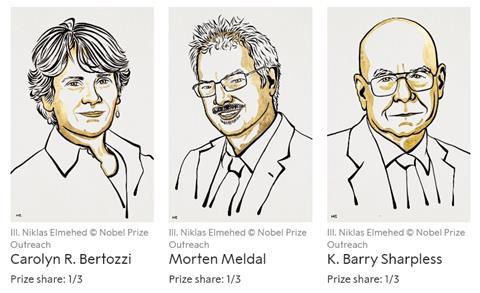The Nobel Prize in Chemistry has been awarded to Carolyn Bertozzi, Barry Sharpless and Morten Meldal for the development of click chemistry and bio-orthogonal chemistry. C2W | Mens & Molecule gathered some responses from the field.
‘Great news and a very deserved award’, responds Sander van Kasteren, professor of molecular immunology at Leiden University. ‘I’m also very happy that Morten Meldal is one of the three winners, because he always got a bit neglected as the inventor of copper click chemistry, though he has been just as important as Barry Sharpless.’ He is backed by Marc Robillard, founder and ceo of Tagworks Pharmaceuticals in Nijmegen, which applies bio-orthogonal click chemistry for drug delivery techniques. ‘It was certainly expected, bio-orthogonal click chemistry has long been mentioned as a contender and for these three to get the Nobel Prize because of it is completely justified.’
Floris Rutjes, professor of organic chemistry at Radboud University, had bet on mRNA technology as the winner. ‘Click chemistry had been on the list to win the prize for a long time, but I actually expected mRNA technology to be the winner this year. The Nobel Prize is not guided by current affairs, however. Purely based on impact, I would have chosen mRNA technology, but click chemistry is also absolutely deserving of the prize.’

Molecular handles
At the turn of the century, Barry Sharpless (Scripps Research, La Jolla) launched the term click chemistry for the copper-catalysed azide-alkyn cycloaddition. A reaction that Sharpless and Morten Meldal (University of Copenhagen) both discovered independently. Then Carolyn Bertozzi (Stanford University) took click chemistry a step further by applying it in living cells, dubbed bio-orthogonal chemistry. This allows you to make tiny molecular tags (‘handles’) that, when they bind to a cell target, exhibit fluorescence. This allows you to visualise processes in the cell quite easily.
Our company is entirely built on bio-orthogonal click chemistry
Bio-orthogonal click chemistry is used in many fields, from medical chemistry and biochemistry to diagnostics and drug delivery. ‘Our company is built entirely on bio-orthogonal click chemistry’, Marc Robillard of Tagworks Pharmaceuticals says. ‘What makes this technique so unique is that you can intervene in biological systems with chemistry, allowing you to do things that biology cannot do without disrupting biological processes. And that has a very wide range of applications in all kinds of fields, including medical and pharmaceutical, think drug delivery and imaging. We are developing new methods to deliver and activate drugs, especially against cancer, in a targeted way in the body. Our click-to-release technology is founded on Carolyn Bertozzi’s research. Without her work, Tagworks would not exist.’
Human dimension
The bio-orthogonal side is also particularly important for Sander van Kasterens’ research. ‘That is really to Carolyn Bertozzi’s credit. Thanks to her work, we can now look at biological processes in cells without changing them. Classical fluorophores, such as proteins, are so large that you are no longer looking at the process you actually want to investigate. With the techniques Bertozzi developed, you can click very small molecules to your target, little handles, so you see the processes in a much more natural way.’ He is happy for Bertozzi for personal reasons too, with whom he was at the Arcade Fire concert just last week. ‘Apart from the enormous scientific importance of her work, I’m also very happy because Carolyn Bertozzi is just incredibly nice and really committed and speaks out for the human dimension in science.’
The handles are very robust, so they survive the breakdown process and can be followed to the end
Live tracking
A key advantage of bio-orthogonal click chemistry is that you can perform reactions on molecules for which there is no genetic basis. Van Kasteren: ‘For sugar molecules, for example; there is no genetic blueprint for which sugar should go where, those are random processes after all. By clicking a small handle on a sugar, we can now follow where a sugar goes and how that changes over time. And you can apply that on many more fronts, including, for example, tracking lipids or all kinds of other biological building blocks.’ His group uses these techniques to follow the degradation of certain substances ‘live’. ‘The handles are very robust, so they survive the degradation process and you can follow them to the end. For example, putting them on a vaccine, which gets completely cut down as it goes along, but you can ‘see’ the piece with your handle for a very long time. And we just put up a paper on BioArXiv in which we have different cells taking up amino acids in competition and we can quantify exactly how much a cell eats. If you use large, fluorescent proteins, that never works.’
Spin-off
For Barry Sharpless, it is his second Nobel Prize, having received the first in 2001. He is the second person to receive a Nobel Prize in Chemistry twice. Rutjes: ‘Sharpless was conceptually at the basis and spent years searching for a click reaction. For him, the discovery of the first click reaction was proof that his ideas were possible. But Meldal found that click response almost simultaneously by chance, but for a very different application. Bertozzi especially put cyclo-octynes on the map.’
The original click reaction was the copper-catalysed alkyn-azide cyclo-addition. ‘But Bertozzi found a way for a metal-free variant’, Rutjes explains. ‘She put a triple bond in an eight-ring to create a strained ring; a spring-loaded or strain promoted alkyne-azide cyclo-addition.’ Subsequently, many groups came up with variations on this. ‘At our spin-off Synaffix, for example, we use a cyclo-octyn developed in our department to achieve antibody-drug conjugation. Click chemistry really spans the entire breadth, both the more fundamental discovery of the first click reactions and biomedical and pharmaceutical applications.’













Nog geen opmerkingen